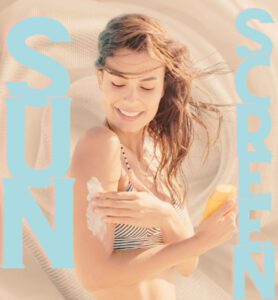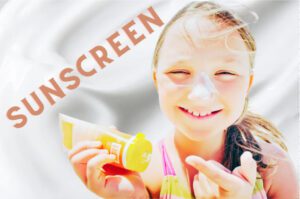Sunscreen : Your Sun-Kissed Guardian
Sunscreen, often relegated to beach bags and summer vacations, is more than just a seasonal necessity. It’s your daily shield against the sun’s relentless ultraviolet (UV) rays, protecting your precious skin from the aging whispers and harmful burns that lurk beneath its warm embrace. This comprehensive guide delves deep into the world of sunscreens, unveiling their science, benefits, and secrets to optimal protection.
UV Rays Unveiled: Understanding Their Impact
The sun’s seemingly benevolent light carries a hidden weapon: ultraviolet radiation. Its two main culprits, UVA and UVB rays, penetrate our skin, leaving behind a trail of damage if left unchecked.
- UVA rays: These sneaky villains burrow deep, wreaking havoc on collagen and elastin, the architects of youthful skin. They contribute to premature aging, wrinkles, and hyperpigmentation.
- UVB rays: These are the tan-inducing (and sunburn-causing) culprits. They target the skin’s surface, causing redness, inflammation, and even blistering. Long-term exposure increases the risk of skin cancer.
Sunscreen, our valiant knight in shining armor, stands guard against these invaders, absorbing or reflecting their rays before they can inflict their harm.
The SPF Spectrum: Choosing Your Armor’s Strength
Sun Protection Factor (SPF) is the numerical measure of a sunscreen’s ability to block UVB rays. It’s your shield’s strength, and choosing the right one depends on your skin’s vulnerability and sun exposure.
- SPF 30: The dermatologist-recommended minimum for daily use, blocking 97% of UVB rays. Ideal for most skin types and moderate sun exposure.
- SPF 50: A stronger shield, blocking 98% of UVB rays. Perfect for extended sun exposure, fairer skin tones, and outdoor activities like swimming or sports.
- SPF 100: The ultimate UVB protection, blocking 99% of rays. Best suited for intense sun exposure, individuals with sensitive skin, or those at higher risk of skin cancer.
Behind the Shield: Unveiling Sunscreen’s Ingredients
Sunscreens come in two main armor types: mineral and chemical. Each has its strengths and weaknesses, making them suitable for different skin types and preferences.
- Mineral Sunscreens: These physical barriers, like zinc oxide and titanium dioxide, sit on the skin’s surface, reflecting and scattering UV rays. They’re generally gentler on sensitive skin but may leave a white cast.
- Chemical Sunscreens: These absorb UV rays and convert them into heat, which is then released from the skin. They offer broader spectrum protection, including UVA rays, but may irritate certain skin types.
Sunscreen Mastery in Action
Proper application is the key to unlocking sunscreen’s full potential. Think of it as strategically deploying your soldiers!
- Generously apply: Don’t skimp! Cover all exposed skin, including the face, neck, ears, lips, tops of feet, and the back of your neck.
- Don’t forget the nooks and crannies: Hands, tops of ears, and the part of your scalp exposed under a hat need protection too.
- Apply early: Give your sunscreen time to absorb, at least 15-30 minutes before sun exposure.
- Reapply diligently: Every two hours, or more frequently if swimming, sweating, or towel-drying, is crucial for continuous protection.
Unseen Benefits of Sunscreen
Sunscreen’s benefits extend far beyond a tan-free summer. It’s an investment in your skin’s health and future:
- Premature aging’s nemesis: By shielding collagen and elastin from UV damage, sunscreen helps prevent wrinkles, fine lines, and age spots, keeping your skin youthful for longer.
- Skin cancer’s silent foe: Regular sunscreen use significantly reduces the risk of developing skin cancers, including melanoma, the most aggressive form.
- Hyperpigmentation’s eraser: Sun exposure can lead to uneven skin tone and dark spots. Sunscreen helps prevent and fade these blemishes, promoting a more even complexion.
- Skin’s health champion: By protecting skin cells from UV damage, sunscreen maintains the skin’s natural barrier function, promoting overall skin health and resilience.

Tailoring Your Sunscreen
With countless options available, choosing the right sunscreen can feel like navigating a labyrinth. But fear not, for your skin’s perfect match awaits! Consider these factors:
- Skin type: opt for mineral-based sunscreens for sensitive skin and oil-free formulas for oily skin.
- Lifestyle: Choose water-resistant options for active lifestyles and sweat-proof formulas if you work outdoors.
- Activity: Look
Unveiled SPF 50 Shield
Sunscreen, that humble hero tucked away in beach bags and summer drawers, deserves a standing ovation. It’s more than just a seasonal necessity; it’s your daily armor against the sun’s relentless ultraviolet (UV) rays, safeguarding your precious skin from the whispers of premature aging and the fiery sting of sunburn. This comprehensive guide delves deep into the world of SPF 50 sunscreens, unveiling their science, benefits, and secrets to optimal protection, empowering you to embrace the sun safely and confidently.
UV Rays Unmasked: Understanding
The sun’s seemingly benevolent light carries a hidden weapon: ultraviolet radiation. Its two main culprits, UVA and UVB rays, penetrate our skin, leaving behind a trail of damage if left unchecked.
- UVA rays: These sneaky villains burrow deep, wreaking havoc on collagen and elastin, the architects of youthful skin. They contribute to premature aging, wrinkles, and hyperpigmentation. Think of them as the architects of fine lines and uneven skin tone.
- UVB rays: These are the tan-inducing (and sunburn-causing) culprits. They target the skin’s surface, causing redness, inflammation, and even blistering. Long-term exposure increases the risk of skin cancer. Imagine them as the sun’s fiery darts, causing immediate damage and potentially long-term harm.
SPF 50 sunscreen stands as a formidable shield against these invaders, absorbing or reflecting their rays before they can inflict their harm. It’s like a bouncer at the door of your skin cells, letting the good light (visible light) in while firmly rejecting the unwanted guests (UV rays).

The Power of 50: Choosing Your Sunscreen
Sun Protection Factor (SPF) is the numerical measure of a sunscreen’s ability to block UVB rays. It’s your shield’s strength, and choosing the right one depends on your skin’s vulnerability and sun exposure. Think of it as selecting the right thickness of your armor for the battle ahead.
- SPF 30: The dermatologist-recommended minimum for daily use, blocking 97% of UVB rays. Ideal for most skin types and moderate sun exposure. It’s like a sturdy chainmail shirt, offering good protection for everyday encounters with the sun.
- SPF 50: The hero of this guide, SPF 50 sunscreen blocks a whopping 98% of UVB rays. Perfect for extended sun exposure, fairer skin tones, and outdoor activities like swimming or sports. Imagine it as a knight’s full plate armor, offering robust protection for even the most intense sun battles.
- SPF 100: The ultimate UVB protection, blocking 99% of rays. Best suited for intense sun exposure, individuals with sensitive skin, or those at higher risk of skin cancer. Think of it as an impenetrable fortress wall, offering maximum security against the sun’s harshest rays.
Unveiling the Science Behind SPF 50
SPF 50 sunscreens come in two main armor types: mineral and chemical. Each has its strengths and weaknesses, making them suitable for different skin types and preferences.
- Mineral Sunscreens: These physical barriers, like zinc oxide and titanium dioxide, sit on the skin’s surface, reflecting and scattering UV rays. They’re generally gentler on sensitive skin but may leave a slight white cast. Think of them as a layer of reflective shields, bouncing back the sun’s harmful rays.
- Chemical Sunscreens: These absorb UV rays and convert them into heat, which is then released from the skin. They offer broader spectrum protection, including UVA rays, but may irritate certain skin types. Imagine them as tiny sponges, soaking up the sun’s harmful energy before it can damage your skin.
Mastering SPF 50 Sunscreen Application
Proper application is the key to unlocking SPF 50 sunscreen’s full potential. Think of it as strategically deploying your sun-defying soldiers!
- Generously apply: Don’t skimp! Cover all exposed skin, including the face, neck, ears, lips, tops of feet, and the often-forgotten back of your neck. Remember, even small areas left unprotected can become sunburned.
- Don’t forget the nooks and crannies: Hands, tops of ears, and the part of your
SPF 100: Your Sunscreen
Sunscreen, often relegated to the sidelines of summer days and beach vacations, deserves a place at the forefront of your daily skincare routine. It’s not just a seasonal shield; it’s your unwavering defender against the sun’s relentless ultraviolet (UV) rays, a fortress safeguarding your precious skin from the whispers of premature aging and the fiery sting of sunburn. This comprehensive guide dives deep into the world of SPF 100 sunscreens, unveiling their science, benefits, and secrets to optimal protection, empowering you to bask in the sun’s warmth with confidence and peace of mind.
Unmasking UV Rays: Decoding Impact
The sun’s seemingly benevolent light holds a hidden arsenal: ultraviolet radiation. Its two main culprits, UVA and UVB rays, penetrate our skin, leaving behind a trail of damage if left unchecked.
- UVA rays: These sneaky villains burrow deep, wreaking havoc on collagen and elastin, the architects of youthful skin. They contribute to premature aging, wrinkles, and hyperpigmentation. Think of them as the silent saboteurs, slowly compromising the skin’s structure and resilience.
- UVB rays: These are the tan-inducing (and sunburn-causing) culprits. They target the skin’s surface, causing redness, inflammation, and even blistering. Long-term exposure increases the risk of skin cancer. Imagine them as the sun’s fiery darts, inflicting immediate damage and potentially long-term harm.
SPF 100 sunscreen stands as an impenetrable fortress against these invaders, reflecting and absorbing their rays before they can inflict their harm. It’s like a high-tech security system, constantly monitoring and neutralizing any potential threats to your skin’s health.
Understanding SPF 100 Pinnacle Protection
Sun Protection Factor (SPF) is the numerical measure of a sunscreen’s ability to block UVB rays. It’s the thickness of your fortress walls, and choosing the right one depends on your skin’s vulnerability and sun exposure. Think of it as selecting the appropriate level of security for your specific needs.
- SPF 30: The dermatologist-recommended minimum for daily use, blocking 97% of UVB rays. Ideal for most skin types and moderate sun exposure. It’s like a sturdy outer wall, offering good defense for everyday encounters with the sun.
- SPF 50: A formidable shield, blocking 98% of UVB rays. Perfect for extended sun exposure, fairer skin tones, and outdoor activities like swimming or sports. Imagine it as a reinforced castle wall, providing robust protection for even the most intense sun battles.
- SPF 100: The pinnacle of UVB protection, blocking a staggering 99% of rays. Best suited for extreme sun exposure, individuals with sensitive skin, or those at higher risk of skin cancer. Think of it as an impregnable fortress, offering maximum security against the sun’s most potent rays.
SPF 100 Shield: Science Revealed
SPF 100 sunscreens come in two main armor types: mineral and chemical. Each has its unique strengths and weaknesses, making them suitable for different skin types and preferences.
- Mineral Sunscreens: These physical barriers, like zinc oxide and titanium dioxide, sit on the skin’s surface, reflecting and scattering UV rays. They’re generally gentler on sensitive skin but may leave a slight white cast. Think of them as a layer of reflective armor, deflecting the sun’s harmful rays before they can penetrate the skin.
- Chemical Sunscreens: These absorb UV rays and convert them into heat, which is then released from the skin. They offer broader spectrum protection, including UVA rays, but may irritate certain skin types. Imagine them as tiny sponges, soaking up the sun’s harmful energy before it can cause damage.

Unlocking SPF 100 Mastery: Application
Proper application is the key to unlocking SPF 100 sunscreen’s full potential. Think of it as strategically positioning your sun-defying soldiers for optimal defense!
- Generously apply: Don’t be stingy! Cover all exposed skin, including the face, neck, ears, lips, tops of feet, and the often-forgotten back of your neck. Remember, even small areas left unprotected can become sunburned.
- Don’t forget the nooks and crannies: Hands, tops of ears, and the part of your scalp exposed under a hat need protection too. Think of them as the hidden vulnerabilities in your fortress that require extra attention.
- Apply early: Give your sunscreen time to absorb, at least 15-30 minutes before sun exposure. Think of it as activating your sun defense system and ensuring it’s fully operational






